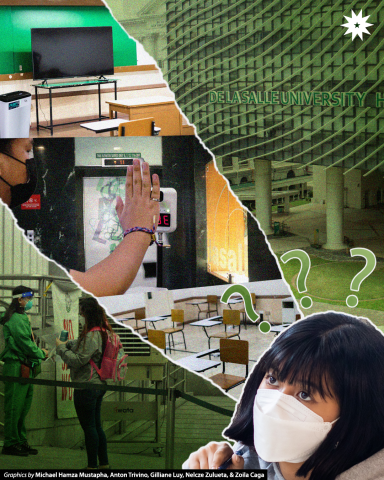Several new health protocols were implemented to ensure the protection of students, faculty, and staff against COVID-19 as the University prepared for the return of face-to-face classes last September.
With the Learning Continuity Plan and operating clinic hotlines in place, the University administration, along with the Health Services Office (HSO), are lowering the risks of the Lasallian community contracting the virus inside the campuses.

Campus reopening, in-person classes
When DLSU campuses slowly began reopening in Term 1, Lasallians were required to register through the Campus Access Registration System for every day of their visit, answer vaccine monitoring forms, and fill up the Daily Health Screening Survey, with the latter required for Laguna campus students.
Forms were no longer needed as hybrid classes of face-to-face and online modes launched in Term 1 Academic Year (AY) 2022-2023, and both vaccinated and unvaccinated students were allowed to enter the campuses.
The Learning and Work Continuity Plan, approved in August by the President’s Council, initially declared that the status of in-person classes would depend on the number of COVID-19 cases within the Greater Manila area. Classes would shift to full online if the positivity rate reached 15 percent or more. However, it was recently revised to depend on the amount of cases respective to each campus.
Dr. Abegail Pineda, director for Campus Services in the Laguna campus, says that HSO has no plans on releasing updated numbers of active cases to avoid “creating panic within the community”.
Instead, HSO privately reports the number of cases to the Council after each week for close monitoring.
The health services committees of the Manila and Laguna campuses also meet to “align protocols” and to make sure that minimal health standards are being followed, as an added safety measure stressed by Pineda.
On verifying documents for approved absences
Although each respective college has its corresponding guidelines for undergraduate students when requesting for approved absences, the University administration opted for unified guidelines for those with medical-related reasons.
Along with the increasing number of COVID-19 related cases within the Manila and Laguna Campus, the HSO mentioned that students may submit their medical certificates to Pineda, Dr. Linoel Cervantes, Dr. Lily Cabuling, and Dr. John Reginald Piano of DLSU Manila. Requests for approved absences are then communicated among the HSO units through DLSU’s Concierge Support Portal, and the school’s physicians may be able to validate the supporting documents from these students’ attending doctors in order to grant medical clearance to reinstate the students’ campus access.
“After the students [take] either antigen or RT-PCR tests, we made it a rule that it [should come] from accredited laboratories. Since we also have it attested by their attending physicians, HSO communicates with these hospitals and clinics’ contact details to verify the necessary information,” Pineda explains.
These doctors should then endorse the validating documents within one week to the associate deans of the student’s respective college in order to formally approve the dates of absences of the afflicted students.
Safety, precautionary measures
Students are expected to observe the designated quarantine or isolation period instigated by the COVID-19 Inter-Agency Task Force for the Management of Emerging Infectious Diseases Resolutions (IATF) prior to requesting medical clearance as they return to campus, Pineda asserts.
Meanwhile, Cabuling raises that infected individuals must inform HSO immediately of any COVID-19 symptoms they exhibit, as they may need to do contact tracing for those who might have been in close contact with these students on campus within two days before they developed symptoms.
Through an online interview with the affected individuals, DLSU’s attending physicians should be able to write a breakdown of people they came into contact with to provide a clinical judgment from the observed common occurrence.
Aside from this, DLSU HSO, in coordination with the maintenance personnel, has spearheaded actions to maintain proper sanitation in all sectors of both campuses by disinfecting classrooms, study halls, and other areas. Pineda highlights that continuing thorough cleaning, installing air purification systems, scanning of temperatures, and practicing social distancing are some of the institutions’ efforts to curb the COVID-19 cases in DLSU’s Manila and Laguna campuses.
